Abstract
The Role Playing is a teaching method based on the simulation of actions related to real life, in which each member of a group plays a specific role previously prepared for its representation. The purpose of this article is to know the influence of the Role playing method in the teaching and learning process of the students enrolled in the Master's Degree in Teaching Compulsory Secondary and Upper Secondary School, Vocational Training and Foreign Language Teaching in the Campus of Ceuta in the school year 2017/2018, in the subject called Organization and Management of Educational Centres. The research is a descriptive and correlative one, applying an analysis from a quantitative approach. The descriptive analysis has been based on the relation between the gender and age variables with the Role Playing dimension formed by nine variables. The results show that the application of this method in the development of the training process has been accepted in a very positive way, being better valued by men aged between 26 and 30 years old, without the existence of a direct relation between the different analysed variables. The conclusions show that the use of the Role Playing is a valid teaching method for those students who are being trained to be teachers, allowing them to deal with diversity, adapting to different paces and learning styles, awakening motivation, favouring the teamwork and making the students develop an active, autonomous and responsible role.
Keywords: Higher educationteaching methodsteacher trainingrole playing
Introduction
The Role Playing, or also called role play, pedagogical psychodrama or simulation emerged in the field of psychotherapy, being considered as one of the main psychodramatic techniques (Padilla, 2000).
In order to define it, there are two clearly differentiated positions. On the one hand, those who define it as a leisure aspect considering it as a system for creating episodic and participatory stories which allows a group of people, led by a responsible, to determine how the interactions among the played characters are resolved (Ramos and Sueiro, 2010). And on the other hand, and this is the one in which we are going to base our research, is applied in the educational field which is considered as a teaching resource or a teaching-learning technique for the training of specific professionals (Padilla, 2000); which allows to revive a situation to understand certain actions and attitudes of the people involved through small representations or dramatizations (Imbernón and Medina, 2008) in a collaborative and cooperative way (Ortíz, Medina and De la Calle, 2010), assigning different roles to the members of a group of students who must propose actions to solve the problems (Hernández, 2010). This tool is being used in the educational field, both in Pre-school Education, Primary Education, Compulsory Secondary Education, Upper Secondary Education, Vocational Training and at the University itself (Lara and Rivas, 2009).
In order to apply the Role Playing in the classroom there must be a methodological change on the part of teachers, moving from an approach based on teaching to another focused on learning (Lara and Rivas, 2009), where the teacher becomes a planner, information facilitator, motivator, creator of stimulating environments, guide and moderator of the training process (Ortiz, Medina, & De la Calle, 2010; Ruiz and Ruiz, 2014; Lara and Rivas, 2009), and the student becomes an active part in his training (Ruiz and Ruiz, 2014; Lara and Rivas, 2009), being an autonomous and participatory person (Ortiz et al., 2010), favouring the development of the competence to learn how to learn (Lara and Rivas, 2009) and the paradigm of learning by doing (Ortiz et al., 2010).
The role playing is considered as an excellent learning technique (Padilla, 2000) which tries to turn the playful into learning promoting the learning of attitudes and values (Hernández, 2010), being more effective than the traditional methods for the formation of several competences (Ortiz et al., 2010). But it is not always the case since the fact of using traditional teaching methods does not lead to bad results given that, at certain times, it is necessary to use them. The ideal thing is to make a combination of different methods so as to obtain the best performance in the student.
As in many learning strategies, this technique could have advantages and disadvantages. With respect to the advantages, we can deduce that it develops interpersonal and communication skills, encourages the research of the student, favours the resolution of conflicts, reduces anxiety, motivates students and allows exploration; while regarding the disadvantages, we can infer the lack of learning motivated by an inexpert feedback, the inadequacy for large groups and complex situations, the ambiguity in the roles to be represented, the lack of knowledge of the variety of roles to be performed, the lack of teacher training (Ortiz et al., 2010) and the bad distribution of the student roles (Ruiz and Ruiz, 2014).
At all times, we must know how to control the disadvantages that may appear while the implementation of this teaching strategy so as to prevent that a malpractice could provoke and unexpected result.
Purpose of the Study
The purpose of this article is to know the influence of the Role-Playing method in the teaching and learning process of the students enrolled in the Master's Degree in Teaching Compulsory Secondary and Upper Secondary School, Vocational Training and Foreign Language Teaching.
Research Methods
Types of research and procedure
The research was carried out using a descriptive and correlative approach by means of a quantitative analysis (Colás and Buendía, 1998). The information collection process took place in March 2018, once the teaching period of the subject "Organization and Management of Educational Centres" had ended.
For that day, the questionnaire designed with Google Drive was created. The link was included in the platform called Prado2 which belongs to the University of Granada so as to the students could access directly to the link and fill in it using the smartphone, the tablet or the laptop.
Before enabling the link in the platform, the procedure the students must follow was explained in order to assure its correct compliance as well as the available time for doing that (20 minutes), although the students conducted it between 14 and 18 minutes.
For the data analysis, the programme IBM SPSS Statics 20 was used. In the univariate analysis, we have obtained percentages while in the bivariate analysis, in order to know the interdependence relation, the Pearson Chi-Square test was employed. In cases where there was not any independence relation, Phi and Cramer's V test was applied so as to know the association force when such variables are mostly ordinal.
Subjects
The analysed population for this research involves every student enrolled in the Master's Degree in Teaching Compulsory Secondary and Upper Secondary School, Vocational Training and Foreign Language Teaching. In particular, 73 was the number of analysed subjects and the percentage of women (54,8%) was higher than the percentage of men (45,2%). The age of the students is variable with a higher percentage of students between 21 and 25 years old (52,1%), followed by those who are between 26 and 30 (30,1%), 31 and 35 (9,6%) and more than 35 (8,2%) respectively.
The specialties of the students are, in order of enrolment, Training and Career Orientation (13.7%), Economy (13.7%), Foreign Language (13.7%), Educational Orientation (9.6%), Sanitary Processes (8.2%), Mathematics (8.2%), Biology and Geology (6.8%), Social Sciences (6.8%), Drawing (6.8%), Spanish Language and Literature (4, 2%), Physics and Chemistry (4.2%), Information and Communication Technology (2.7%) and Physical Education (1.4%).
Instrument
The instrument used for the research is an ad hoc questionnaire developed with the intention of assessing the aim. The instrument consists of a total of 20 dimensions divided into two areas, one called "Information and Communication Technologies" (9 items) and another called "Role Playing" (9 items), apart from the sociodemographic data, gender and age. The instrument has been subjected to validity of content made by 5 expert doctors on the subject. Their recommendations were focused on the inclusion of certain elements, the elimination of others and the improvement in the drafting of them.
For reliability, we used the Cronbach's Alpha coefficient of internal consistency by means of a pilot test applied to 30 students during the academic year 2016/2017. The average value of Cronbach's Alpha in the field of Information and Communication Technologies is 0.891, while in the Role Playing field it is 0.769, both being considered acceptable when being higher than 0.70 established by authors such as George and Mallery (2003).
Findings
Descriptive analysis
When establishing the descriptive analysis, we wanted to know the opinions about the diverse questions raised from two perspectives; on the one hand, the gender and on the other hand, the age trying to observe what differences occur in their opinions.
We can deduce similar results in terms of gender when considering the Role Playing technique as a means to solve problematic situations, making use of different types of knowledge, skills, attitudes and values whose assessments are positive, although they are better valued by men (50%) than by women (44.4%).
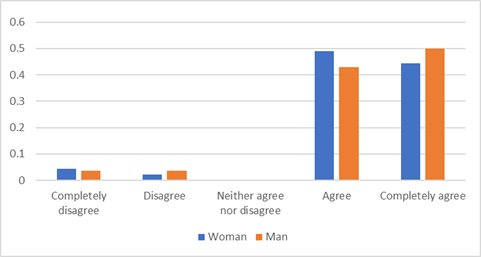
In order to know whether the role playing is adapted to different paces and learning styles, it is observed similar results as in the previous item, being valued more positively by men (32.1%) than by women (24.4%).
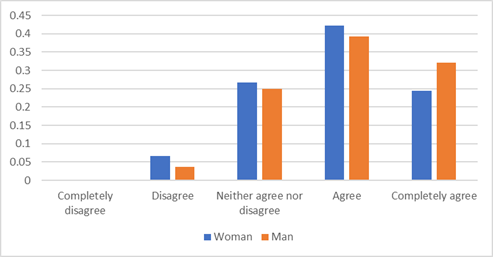
Following the same keynote as before, there are no significant differences between men and women when it comes to assess positively the adaptation to different paces and learning styles provided by the simulated learning.
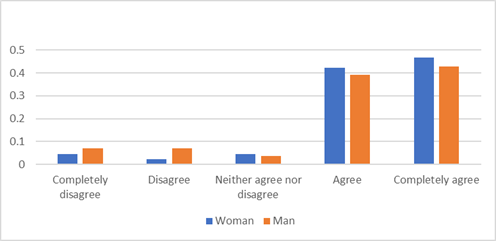
When considering Role Playing as a means to boost the teamwork, there are small differences despite they are not significant, depending on the gender, whose assessments remain positive, although slightly higher in women (51.1%) than in men (35.7%).
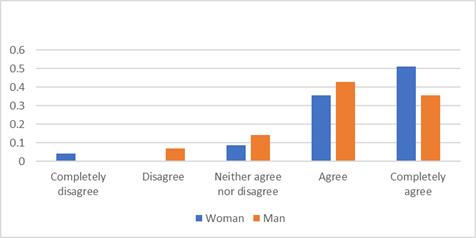
Focusing now on the age, it is observed that the assessments are still positive when considering the role playing technique as a means to solve problematic situations, being valued in a more remarkable way by students whose ages are comprised between 26 and 30 years old (54.2%).
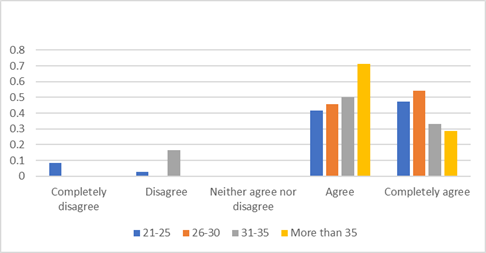
When it is considered if the Role Playing is adapted to different paces and learning styles, although they are similar with regard to age, the assessments are not as positive as they were previously, being better valued by the ages comprised between 31 and 35 years old (50%).
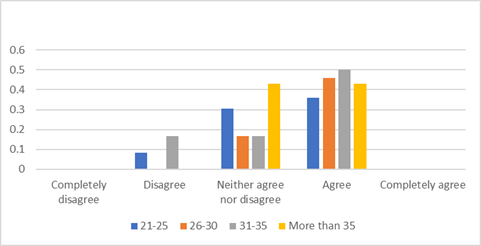
With respect to whether the simulated learning favours the active, autonomous and responsible role of the students in relation to their learning, although the assessments are positive, there are significant differences depending on the age of the respondents, being highly valued by students of ages comprised between 21 and 25 years old (52.8%), face to those aged between 31 and 35 (16.7%) who had a poorer opinion.
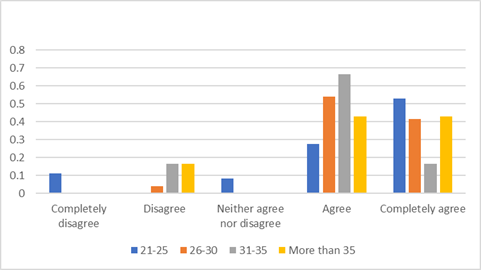
Finally, they exist small variations in the opinions offered by the students when considering the Role Playing as a method which fosters the teamwork, although they are still positive, they are better valued by the ages comprised between 21 and 25 years old (50%).
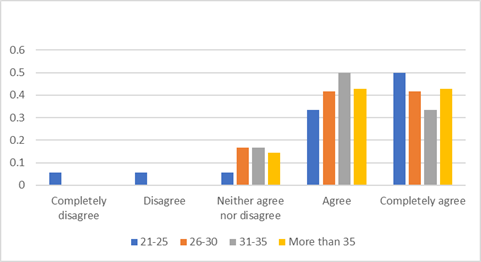
Correlative analysis
H1. The gender influences the consideration that teachers have about the Role Playing, whose problematic situations must be solved by using different types of knowledge, skills, attitudes and values.
H2: "The gender influences teachers' consideration of whether the role playing boosts the adaptation to different paces and learning styles".
H3: "The gender influences the consideration teachers have about the Role Playing, in which the student must play an active and autonomous role and has to be responsible for his learning".
H4: "The gender influences the consideration teachers have about if the Role Playing increases the teamwork".
H5: "The gender influences the consideration teachers have about the Role Playing, whose situations and problems must be solved by using different types of knowledge, skills, attitudes and values”.
H6: “The age influences the consideration teachers have about if the Role Playing promotes the adaptation to different paces and learning styles”.
H7: "The age influences the consideration teachers have about the Role Playing, in which the student must play an active and autonomous role and must be responsible for his learning".
H8: “The age affects the opinion teachers have about if the Role Playing promotes the teamwork”.
Conclusion
In general terms, it is observed that the use of role playing in teaching and learning processes is positively valued by students enrolled in the Master's Degree in Teacher Training of the Autonomous City of Ceuta. More specifically, and focused on the gender of the students, we can determine that men value better than women, in relation to the use of role play, which favours the resolution of problematic situations by using different types of knowledge, skills, attitudes and values; It adapts to different rhythms and learning styles.
On the other hand, women value, more than men, that role play generates an active, autonomous and responsible role for students in relation to their learning, in addition to promoting teamwork.
In relation to age, it is observed that people between 26 and 30 years value more positively than the rest the fact that the role play solves problematic situations by making suo different types of knowledge, skills, attitudes and values.
Those who are between the ages of 31 and 35 years, value more positively the adaptation of this teaching method to different rhythms and learning styles.
Those between 21 and 25 years old consider that role play generates an active, autonomous and responsible role for students in relation to their learning, in addition to promoting teamwork
All this is consistent as indicated by Padilla (2000) indicated, as a means that promotes the solution of problems employing different types of knowledge, skills, attitudes and values. It also promotes the adaptation to different learning styles and paces; it generates an active, autonomous and responsible role for the learner; and it favours the teamwork.
There are no significant differences in the assessments given by the respondents according to their gender, although there are small variations according to the age of the respondents, being better valued by those students whose ages comprise 21 and 25 years old.
It is observed that there is no correlation between the variables gender and age and the rest. According to that fact, it is determined that both elements do not influence when expressing an opinion in relation to the Role Playing as a teaching and learning resource.
References
- Colás, B., & Buendía, L. (1998). Investigación Educativa. Sevilla: Ediciones Alfar.
- George, D., & Mallery, P. (2003). SPSS from Windows stepbystep: A simple guide and reference 11.0 update (4th ed.). Boston: Allyn & Bacon.
- Hernández, J. (2010). Cambio de actitudes y valores ante la energía tras el uso de un juego de rol. Revista Teoría de la Educación: Educación y Cultura en la Sociedad de la Información, 11(3), 135-148.
- Imbernón, F, & Medina, J.L. (2008). Metodología participativa en el aula universitaria. La participación del alumnado. Cuadernos de docencia universitaria 04. Barcelona: ICE y Ediciones Octaedro.
- Lara, S., & Rivas, S. (2009). Aprendizaje autorregulado y fomento de competencias en dos asignaturas de máster a través del empleo de plantillas de evaluación, método del caso, role playing y vídeo digital. Educación XX1, 12, 67-96.
- Ortiz, M., Medina, S., & De la Calle, C. (2010). Herramientas para el aprendizaje colaborativo: una aplicación práctica del juego de rol. Revista Teoría de la Educación: Educación y Cultura en la Sociedad de la Información, 11 (3), 277-300.
- Padilla, E.M. (2000). Role-playing de situaciones conflictivas entre el niño con discapacidad, la familia y la escuela: una experiencia dentro del aula. Revista de Enseñanza Universitaria, Extraordinario, 171-194.
- Ramos, P., & Sueiro, M.J. (2010). Personalidad y elección de personajes en los juegos de rol: dime quién eres y te diré quién prefieres ser. Revista Teoría de la Educación: Educación y Cultura en la Sociedad de la Información, 11 (3), 8-26.
- Ruiz, M.J., & Ruiz, I. (2014). La recreación del universo profesional en el aula a través de técnicas de aprendizaje colaborativo: el método del caso y el juego de rol. Historia y Comunicación Social, 19, 223-234.
Copyright information

This work is licensed under a Creative Commons Attribution-NonCommercial-NoDerivatives 4.0 International License.
About this article
Publication Date
09 April 2019
Article Doi
eBook ISBN
978-1-80296-059-4
Publisher
Future Academy
Volume
60
Print ISBN (optional)
-
Edition Number
1st Edition
Pages
1-1062
Subjects
Multicultural education, education, personal health, public health, social discrimination,social inequality
Cite this article as:
Guerrero, A. J. M., & Belmonte, J. L. (2019). Assessment Of The Use Of Role Playing In The Secondary Master. In E. Soriano, C. Sleeter, M. Antonia Casanova, R. M. Zapata, & V. C. Cala (Eds.), The Value of Education and Health for a Global, Transcultural World, vol 60. European Proceedings of Social and Behavioural Sciences (pp. 438-447). Future Academy. https://doi.org/10.15405/epsbs.2019.04.02.56

